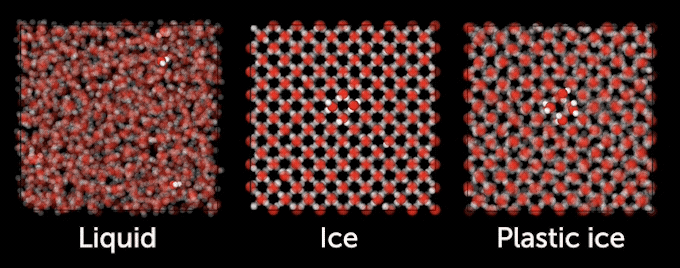A strange type of ice has just been observed.
It forms at high temperatures and pressures. It possesses traits of both solid ice and liquid water. And researchers have now directly observed it for the first time. They described their findings February 12 in Nature. What they observed may also help scientists better understand worlds beyond Earth.
Plastic ice is “something intermediate between a liquid and a crystal,” explains Livia Bove. She’s a physicist at CNRS in Paris. “You can imagine that it is softer when you squeeze it.” It’s called plastic ice because it is more easily molded or deformed than typical crystalline ice. Scientists refer to this Play-Doh-like trait as plasticity.
Explains Bove, it’s “like something that can [squeeze] through a hole and come out, even if it’s still solid.”
The molecules that make up ordinary ice sit in a hexagonal, honeycomb-like shape. Ice cubes, glaciers and snow contain this type of ice. It’s formally known as ice Ih.
In addition to Ih, there are at least 20 other known ice phases. They form under different conditions of pressure and temperature.
At pressures above about 20,000 kilograms per square centimeter (285,466 pounds per square inch), ice smooshes into what’s known as ice VII. It’s densely packed molecules are ordered like the cubies in a Rubik’s Cube. Ice VII has been found trapped in diamonds from Earth’s mantle. It’s also thought to occur inside other planets.
Some ice phases exist only in theory. They’ve never been seen.
More than 15 years ago, computer models predicted what would happen if ice VII were heated and put under extreme pressure. As in a liquid, its individual water molecules should start to rotate freely. Yet those molecules also should stay in one place — as in a solid.
Since this simulated phase shared the same cubic crystal structure as ice VII, it became known as plastic ice VII. But scientists didn’t know whether it truly existed. Running tests at such high pressures wasn’t possible, back then.
For the new study, Bove was part of a team that used a relatively new tool. It can measure the motions of molecules under extreme pressures. It does this by shooting them with tiny particles called neutrons.
Those neutrons interact with molecules in their samples. Depending on the molecules’ motion, the neutrons gain or lose energy — then scatter away toward a detector. Measuring the scattered neutrons’ energies allowed Bove’s team to figure out how the ice molecules moved. From this, they could identify the ice phase that had formed.
Above 177° Celsius (350° Fahrenheit) and at a pressure about 28 times that of the deepest point in Earth’s oceans, Bove’s team observed plastic ice VII. As expected, its structure formed a cubic-crystal lattice. And its molecules rotated about as fast as those in liquid water.

However, one detail differed from what had been predicted. Rather than revolve freely, plastic ice VII’s molecules appeared to swivel in jerky motions. As they revolved, they broke hydrogen bonds that had held them to a neighbor. Then they quickly turn and bond with another, Bove explains. These jumpy rotations may make plastic ice more elastic than if its molecules rotated freely. It also may conduct heat better.
Plastic ice VII may have existed early in the formation of not only Jupiter’s moon Europa, but also other icy moons in our solar system, such as Saturn’s Titan, says Baptiste Journaux. He’s a planetary scientist at the University of Washington in Seattle. Plastic ice VII could have formed then because water hadn’t escaped yet from those moons’ high-pressure interiors, he explains.
The new observations could help researchers piece together the story of how these moons changed over time, he says.
And beyond our solar system, the strange ice may be found on the bottom of super deep oceans on exoplanets. Scientists think plastic ice may cover the seafloors of their oceans.
It would be interesting to find out whether seafloor nutrients could move through plastic ice and into the oceans above, Journaux says. “That would actually feed the ocean with more nutrients.” And those nutrients could make the oceans more habitable, he says.



